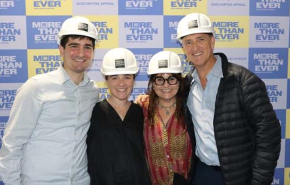Israeli innovation in step length monitoring offers hope for patients with neurological disorders
In an advance for medical monitoring, Israeli researchers have developed an innovative method for more accurate and continuous tracking of step length as a marker for neurological diseases and age-related conditions.

TAU – Tel Aviv public research university. Tel Aviv Photo by Eitan Elhadez-Barak/TPS
In simple terms, step length is the distance from the heel of one foot to the heel of the other foot when taking a step. Researchers at Tel Aviv University (TAU) and the Tel Aviv Sourasky Medical Centre-Ichilov Hospital developed an algorithm that collects data from a lightweight sensor worn on a person’s lower back into precise measurements of step length.
“Step length is a sensitive and non-invasive measure of a wide range of problems associated with aging, cognitive decline, and many neurological diseases, such as Parkinson’s, Alzheimer’s, and multiple sclerosis,” the researchers stated. “Our model enables continuous monitoring of this key aspect of a patient’s condition in daily life.”
A study of the device, recently published in the peer-reviewed Digital Medicine, found the model is nearly four times more accurate than the current biomechanical means of measuring step length.
“Step length is a very sensitive and non-invasive measure for evaluating a wide variety of conditions and diseases,” said TAU Professor Jeffrey Hausdorff. “Current methods require stationary and cumbersome devices only found in specialized clinics and laboratories. Our model enables accurate measurement in a patient’s natural environment throughout the day, using a wearable sensor.”
Measuring step length is often used in various fields, including healthcare and rehabilitation, sports and biomechanics, and studies of mobility and aging.
The researchers utilized inertial measurement unit (IMU) systems, commonly found in smartphones and smartwatches, to develop their model. These sensors, which are light and relatively inexpensive, measure various walking parameters. Although previous studies explored IMU-based devices for assessing step length, they were limited to healthy subjects and small sample sizes.
TAU Prof. Neta Rabin, a machine learning expert, explained, “We sought to develop an efficient and convenient solution suitable for people with walking problems, such as the sick and the elderly. Our goal was to create an algorithm capable of translating IMU data into an accurate assessment of step length, integrated into a wearable and comfortable device.”
The algorithm development involved analyzing IMU sensor-based gait data and conventional step length data from a diverse group of 472 subjects, including individuals with Parkinson’s, mild cognitive impairment and multiple sclerosis, as well as healthy elderly and young adults. This comprehensive dataset comprised 83,569 steps, providing a foundation for training the machine learning models.
“We found that the model called XGBoost is the most accurate, being 3.5 times more precise than the most advanced biomechanical model currently used. For a single step, the average error of our model was 6 cm, compared to 21 cm with the conventional model. When averaging 10 steps, the error reduced to less than 5 cm, a clinically significant threshold,” explained graduate student Assaf Zadka.
The team is exploring the integration of similar models into smartwatches, further enhancing comfort and usability for patients.









